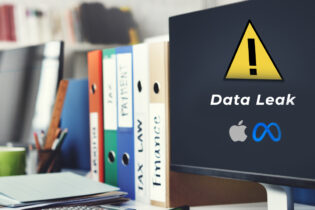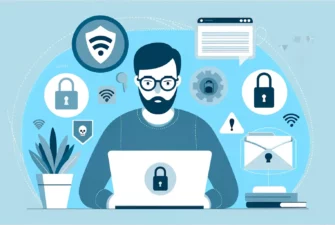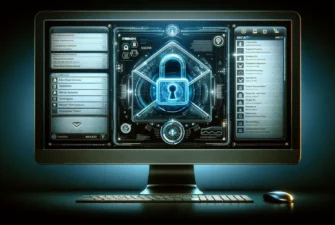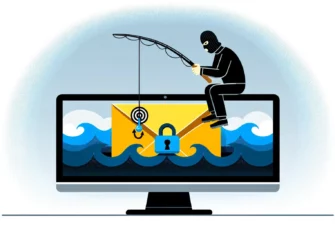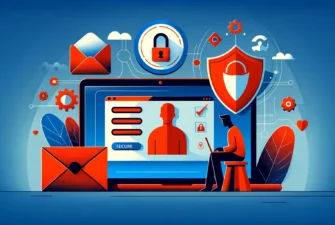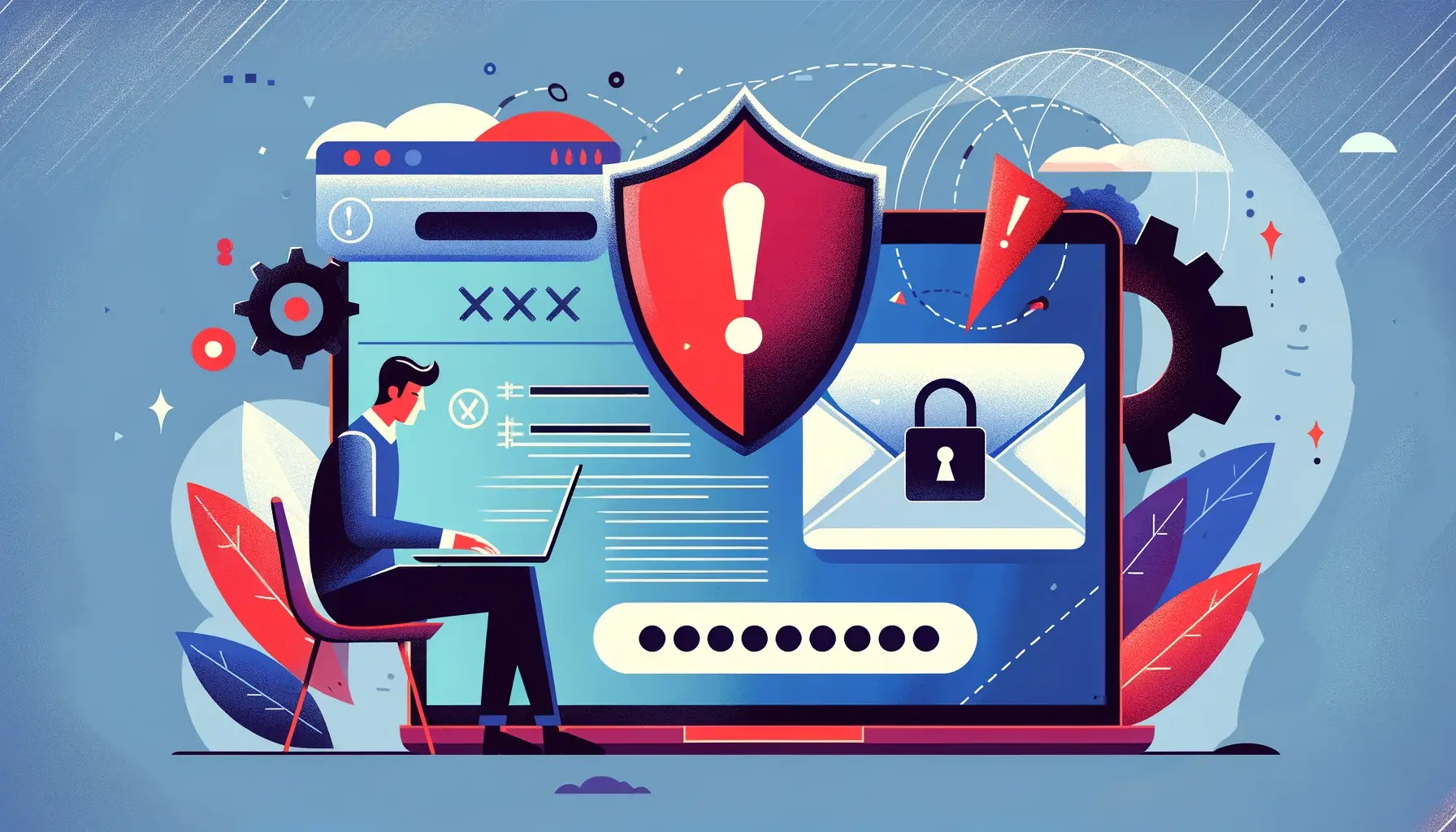
Securing an email server is essential in today’s digital space. With various threats lurking, users must fortify their defenses effectively. From strengthening password policies to encrypting data transmission and utilizing anti-malware solutions, employing balanced strategies to enhance mail server security is a measure every individual and company should prioritize.
Stick around as we unpack these methods one by one, bringing you the ultimate mail server protection.
10 Ways to Secure Your Mail Server
Securing email servers demands a multi-faceted approach. You’ll need to implement basic and advanced settings that cover everything from passwords to server-side specifications.
You can significantly reduce the potential risks of data breaches or cyber-attacks with the help of these strategies. Below, you’ll find 10 ways to strengthen email server security:
1. Implement Strong Password Policies
Let’s start with the very basics. You can have the most secure email server, but if your passwords are weak, your exchanges could fall into the wrong hands.
To bolster security, you should enforce strict rules for password complexity, including upper and lower case letters, numbers, and special characters. Set a minimum password length and change it periodically for the best practices.
Next, you should enable two-factor authentication (2FA) for email and server access. This security measure requires users to provide two authentication factors to verify themselves. Typically, it’s a combination of something you know (like a password), something you have (like a physical token or access to a specific device), and something you are (like a fingerprint or other biometric element).
Nowadays, 2FA is an indispensable addition to unauthorized access, even in the event of password compromise. Most email systems support 2FA, and enabling it is a straightforward process. Don’t overlook this vital step in securing your server.
2. Use SSL/TLS Encryption for Data Transmission
Secure Sockets Layer (SSL) and Transport Layer Security (TLS) are cryptographic protocols that provide email server security by encrypting data during transmission. Even if an attacker intercepts the data, they won’t be able to decipher it.
You should always use the latest versions of SSL/TLS to protect against man-in-the-middle attacks and data tampering. To do this, secure your server with an SSL certificate and get an S/MIME certificate to protect personal and corporate email traffic.
S/MIME certificates secure email communication, providing encryption and digital signatures to ensure the confidentiality, integrity, and authenticity of outgoing and incoming emails.
3. Employ Anti-Malware and Anti-Phishing Solutions
Securing corporate email servers from outside attacks like viruses and ransomware often involves efficient anti-malware solutions. These tools scan incoming emails and attachments in real time, removing any threats before they harm your device. By detecting and neutralizing malware, you can ensure that your sensitive information remains safe and your system stays secure.
Phishing attacks are another common threat affecting email accounts worldwide. To shield mail servers from phishing, like sneaky business email compromise attacks, you should do the following:
- First, set up tight email checks like SPF, DKIM, and DMARC (more on them later) to confirm who’s sending what. Keep security software up-to-date and quickly fix any weak spots.
- Teach your crew about spotting phishing tricks and reporting dodgy emails. Use top-notch tools to sniff out and block phishing emails.
- Watch mail server logs for anything fishy and immediately jump on any suspicious activity.
These moves lock down mail servers from phishing, keeping business emails safe.
4. Tackle Email Spam Efficiently
Protecting your server from mass spam emails requires a sound strategy and regular refinements. Use content filtering to spot patterns associated with sending spam and sender verification to confirm email authenticity. Pair these with IP reputation checks to assess sender trustworthiness when sending mass spam emails.
For example, services like SpamAssassin automatically analyze emails based on various criteria, helping identify and segregate spam messages from legitimate ones.
Next, deploy spam detection tools that continuously learn from marked spam emails. For instance, machine learning algorithms improve over time in identifying and categorizing spam, including spam messages. They assign scores to emails based on header and content analysis, helping automate spam detection and user relief from unwanted messages.
Finally, stay updated with the latest antispam solutions to adapt to evolving spam tactics. Regularly update filtering rules, blacklists, and whitelists to match new techniques for sending mass spam emails. With these proactive measures, your mail server can effectively combat spam and ensure smooth email communication.
5. Configure Firewalls to Restrict Unauthorized Access
A firewall setup is super important for keeping your mail server safe. Make tough rules that only let good stuff through on email ports like SMTP, POP3, and IMAP. Use controls based on trusted IP addresses to stop any sneaky access attempts. Keep an eye on firewall logs and change rules to beat new threats and keep your mail server safe.
Enforce intrusion prevention systems (IPS) alongside traditional firewall rules. IPS systems can actively detect and block suspicious activity, such as brute force attacks or unauthorized access attempts before they reach your mail server.
Furthermore, deploy a web application firewall (WAF) to protect webmail interfaces and other mail-related web applications from common threats like SQL injection and cross-site scripting (XSS) attacks. WAFs inspect incoming web traffic and filter out malicious requests, helping to prevent potential compromises of your mail server through web-based vulnerabilities.
6. Configure DKIM (DomainKeys Identified Mail)
DomainKeys Identified Mail (DKIM) adds an encrypted signature to your emails, which your recipients’ servers can then use to verify that the email genuinely came from your domain and hasn’t been tampered with during transit.
Start by generating a pair of cryptographic keys – a private one that stays on your server and a public one that you publish in your domain’s DNS records. Your server will use the private key to sign outgoing emails, and recipients will use the public key to verify the signature.
Once you generate the keys, the private key is securely stored on your server and never shared. When an email is sent from your domain, your server uses the private key to create a unique cryptographic signature for that message. This signature is then appended to the email headers.
Recipients’ mail servers can retrieve the public key from your domain’s DNS records and use it to decrypt and verify the signature. If the signature matches the message content and other parameters, it confirms the email’s authenticity and integrity.
7. Set Up SPF (Sender Policy Framework)
How can you further enhance your email server’s security? Setting up the Sender Policy Framework (SPF) is a critical step you shouldn’t overlook. This email authentication method prevents spammers from sending emails on behalf of your domain. Here’s how you can set it up.
First, create a TXT record in your Domain Name System (DNS). This record should outline which mail servers you authorize to send emails on your domain’s behalf. When an email is sent, the receiving server checks the SPF record. If the email originates from an approved server, it’s accepted. If not, it’s rejected or marked as spam.
If your domain uses multiple third-party services to send emails, you must carefully manage SPF records to avoid conflicts or exceeding DNS lookup limits. You can either consolidate multiple SPF records into a single record or use mechanisms like “include” to reference other SPF records.
8. Implement DMARC
DMARC, which stands for Domain-based Message Authentication, Reporting, and Conformance, is a protocol that uses SPF and DKIM to verify that the sender’s purported domain hasn’t been impersonated.
With DMARC, you protect your domain from being used in phishing scams, spoofing, and other cyberattacks. This protocol also gives you control over your email delivery process by specifying how your domain handles suspicious emails.
DMARC also enhances email deliverability by allowing you to instruct email providers on how to handle messages that fail authentication. By monitoring DMARC reports, you can gain insights into the unauthorized use of your domain and take action to maintain the integrity of your email communications.
Set up your DMARC record in your domain’s DNS settings, then monitor your DMARC reports regularly to improve your email security.
9. Conduct Regular Security Audits
Security audits are equally important. They offer an in-depth understanding of your mail server’s state and identify vulnerabilities and weak points that cybercriminals could exploit.
These audits extensively examine your server security protocols to ensure they’re up to par. They’re a fundamental part of secure email server work, and you should run them on a pre-defined schedule. Here are some examples of mail server audits:
- Access Control Audit: Only authorized personnel can access sensitive email data by reviewing user permissions and administrative privileges.
- Configuration Audit: Verifies that email server settings, including encryption and spam filter configurations, comply with security best practices and organizational policies.
- Data Integrity Audit: Validates the integrity of stored email data by detecting unauthorized modifications or deletions through log analysis and activity records.
- Compliance Audit: Ensures email server operations align with regulatory requirements such as GDPR or HIPAA, safeguarding sensitive information in emails.
- Security Audit: This audit identifies and addresses security vulnerabilities within the email server infrastructure, including firewall configurations and incident response procedures.
10. Train Users On Email Security Best Practices
In a corporate environment, training users on email security best practices isn’t just about sharing knowledge; it’s about building a culture of security. Start by creating comprehensive, easy-to-understand training materials.
These should cover basic principles, such as the importance of strong, unique passwords, recognizing phishing attempts, and the dangers of downloading attachments from unknown sources.
Regularly update this training to address new threats. Conduct frequent, interactive sessions and create interactive quizzes or simulations that mimic real-world email security scenarios, allowing users to practice identifying suspicious emails or responding to potential threats in a safe environment.
Test users’ understanding and provide feedback. Remember, even the most secure systems can be undermined by user error.
Why Is Mail Server Security Important?
Emails are the lifelines of communication, bridging distances and connecting people globally. Imagine your emails as tiny digital envelopes, each carrying a piece of your personal or professional life – from confidential documents to heartfelt messages. Now, picture someone prying open those envelopes, peeking into your private affairs, or worse, tampering with the contents.
A secure mail server acts as the watchful guardian of your virtual mailbox, warding off malicious intruders and ensuring that your messages reach their intended recipients untouched and untainted. It stands between your sensitive information and cyberspace, shielding you from phishing scams, malware attacks, and data breaches that could compromise your privacy and finances.
Moreover, in today’s interconnected world, a compromised mail server isn’t just a personal problem; it’s a potential gateway for cybercriminals to infiltrate entire networks, affecting individuals, businesses, and even governmental institutions.
Remember, security isn’t just about protecting your data; it’s about the integrity of our digital ecosystem.
So, whether you’re a tech-savvy entrepreneur, a diligent employee, or simply someone who values online privacy, understanding mail server security will keep your email server and sensitive data safe.
Bottom Line
Mail server security should be your top priority once you set up personal or corporate email hosting. With so many threats and vulnerabilities, you should at least deny unauthorized access and prevent spam distribution. However, if you implement all the tips and strategies in this article, your server will be almost unreachable.
This holistic approach enhances security for a mail server and provides a safe and reliable email environment for users to send mail without fear of spam or security breaches.
Save 10% on SSL Certificates when ordering today!
Fast issuance, strong encryption, 99.99% browser trust, dedicated support, and 25-day money-back guarantee. Coupon code: SAVE10























